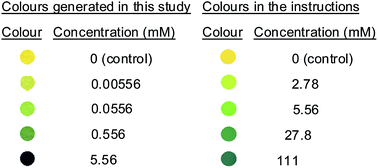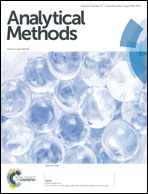Precise micromolar-level glucose determination using a glucose test strip for quick and approximate millimolar-level estimation
Abstract
A variety of test strips for the quick and rough estimation of analytes are commonly and reasonably available. Although the quickness is one of the advantages of test strips, the detection limit can be assumed to be much greater than the actually achievable values, because the quickness suggests the possibility of increasing the sensitivity by extending the reaction time. In this study, a home-use test strip product for urinary glucose detection was examined. When the reaction time of 30 seconds indicated in the instructions was extended to be three hours, the sensitivity increased 56-fold. A detection limit of 3.7 μM glucose was achieved, while the lowest concentration for colour production shown in the instructions was 2.78 mM. The sensitivity is moderately good among the various methods for glucose determination and is comparable to that of widely used high performance liquid chromatography and capillary electrophoresis and recently emerging non-enzymatic sensors. The application was demonstrated by determining glucose generated by the hydrolysis of cellulose in soil–water–cellulose suspensions. The sensitivity-increasing utilization of the convenient, reagentless, safe, cost-effective, and thus highly practical product by extending the originally-instructed reaction time is reported herein.


 Please wait while we load your content...
Please wait while we load your content...